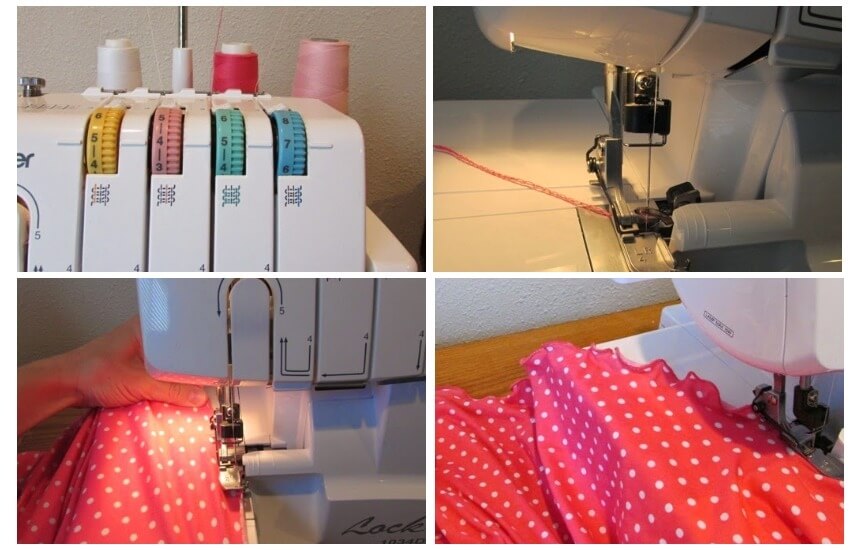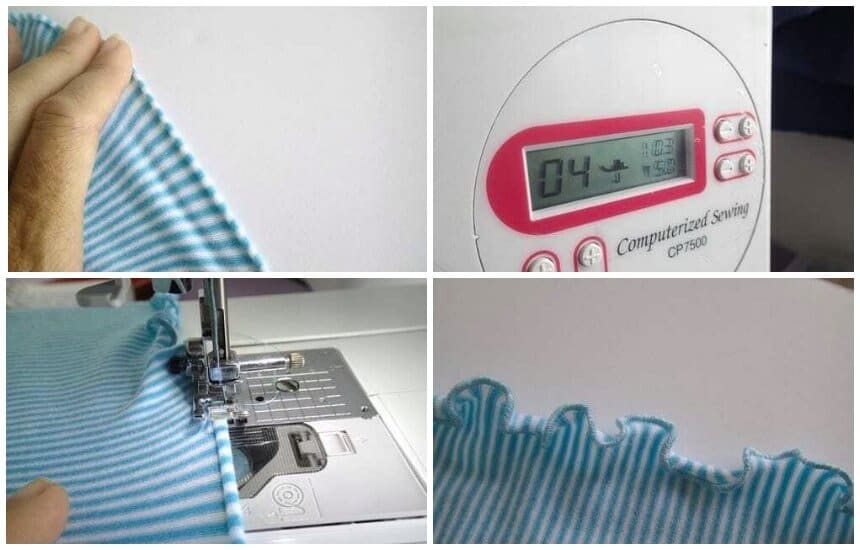

Lettuce hem provides a lovely edge finish for stretch fabric items. It’s not hard to figure out where its name comes from. The edges look a bit like the wrinkles on lettuce. Traditionally, the hemming technique can be done with a Serger, but you can sew it on conventional machines easily with a zigzag stitches.
In this article, we will explain to you what lettuce hem means and show you how to give it a try. It might not surprise you to learn that this is a sewing technique. It’s actually not that rare. If you’ve ever looked at the bottom of a shirt or skirt and seen a “wavy” look, you’re most likely looking at a lettuce hem.
 A lettuce hem is a very decorative stitch finish that you can make on ruffles, sleeves, bodices, and more. A lettuce hem is called so because of its resemblance to a lettuce leaf. They are ideal on garments that are made of knit fabric. It’s a lot like rolled hem but it has an edge that is stretched-out deliberately, hence, making a rippled effect.
A lettuce hem is a very decorative stitch finish that you can make on ruffles, sleeves, bodices, and more. A lettuce hem is called so because of its resemblance to a lettuce leaf. They are ideal on garments that are made of knit fabric. It’s a lot like rolled hem but it has an edge that is stretched-out deliberately, hence, making a rippled effect.
Sewing a lettuce edge hem onto a garment will give it a cute curly effect that is very feminine. This type of hem produces a smoothly ruffled edge that is similar to the edges of curly lettuce leaves.
The lettuce edge hem is easy to sew and can be done with a regular zigzag stitch on a conventional sewing machine, but it is even easier if done with a serger sewing machine. Start by practicing on an ordinary shirt to sew this type of hem and then on to other more elegant clothing such as a blouse or skirt.
To make a lettuce hem, you need quality embroidery or all-purpose cotton or polyester threads.
A lettuce hem can be sewn only on stretchy fabrics. Stretch fabrics stretch a lot along the cut edge. However, a woven fabric wouldn’t; hence, this isn’t great for making lettuce hem.
So, you’ll get great results with stretch fabrics that are thin and can curl a lot. These can be spandex, knits, sateen, stretch cotton, stretch silk, stretch wool, stretch velvet, stretch lace, organza fabric, and more.
You can try out making a lettuce hem with a computerized or mechanical sewing machine. A simple serger, also called an overlocking machine, can also give you great results.
Lettuce edges are a great decorative way to finish your hems. They’re very feminine. They are a lot of fun to make and they’re super easy. You can do this on a knit fabric either a jersey or anything that stretches. The technique to get the good full-volume curvy edges is to pull on the fabric as you’re feeding it.
You should use threads that have a lot of recoveries. These are the most ideal with the lettuce edge.
Do you have a serger or a conventional sewing machine? Below, we will give you the instructions on sewing a lettuce hem on sergers and sewing machines.
 You can use an overlocker or a serger to make shoulder ruffles on your dress. You can find the free pattern online. The ruffles would also go nicely with a mock neck top pattern. For those who don’t have a serger yet, according to most reviews, the sturdiest model must be the Baby Lock Vibrant Serger Machine, which, thanks to its reinforced construction, is the most reliable option out there.
You can use an overlocker or a serger to make shoulder ruffles on your dress. You can find the free pattern online. The ruffles would also go nicely with a mock neck top pattern. For those who don’t have a serger yet, according to most reviews, the sturdiest model must be the Baby Lock Vibrant Serger Machine, which, thanks to its reinforced construction, is the most reliable option out there.
To create the narrow stitch, follow the steps below:
 Sewing a lettuce edge hem on a garment will give it a beautiful, very feminine curly effect. This type of hem produces a slightly tousled edge that resembles the edges of leaf lettuce. A lettuce hem is easy to make and you can do this with the zigzag stitch on conventional sewing machines. Follow the process below:
Sewing a lettuce edge hem on a garment will give it a beautiful, very feminine curly effect. This type of hem produces a slightly tousled edge that resembles the edges of leaf lettuce. A lettuce hem is easy to make and you can do this with the zigzag stitch on conventional sewing machines. Follow the process below:
Sewing a lettuce hem is an easy process. This can be done on a sewing machine or a serger machine. First, you have to roll up the edge. But we advise that you test a piece of fabric to make sure that your technique and stitch length are correct. If your fabric is curly, it will be very easy. Just flip it over with your fingers, without ironing. It doesn’t matter if the front or back of the fabric is facing up, as the zigzag stitches will cover the edges.
Set the width of the zigzag stitch. Your machine may have satin stitch applique and it may work well. Stretch your fabric as while ensuring you have a small egde folded. The zigzag will extend past the edge as well as the crease. When you’re done making the lettuce hem, let the fabric relax back into shape.